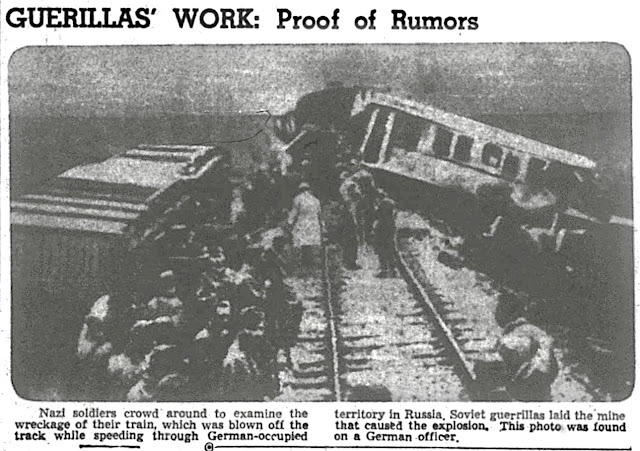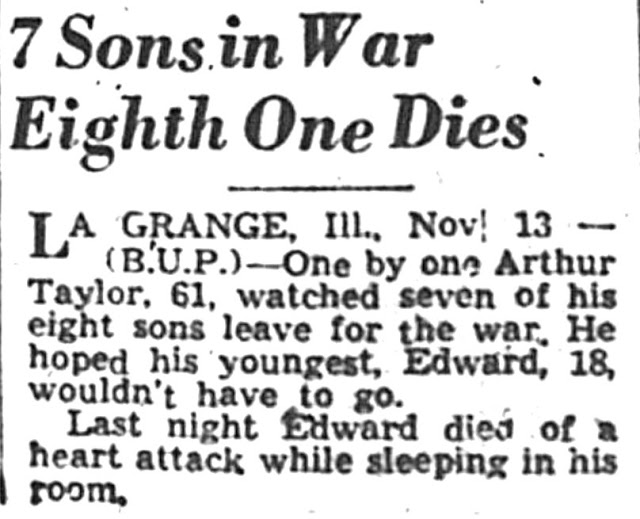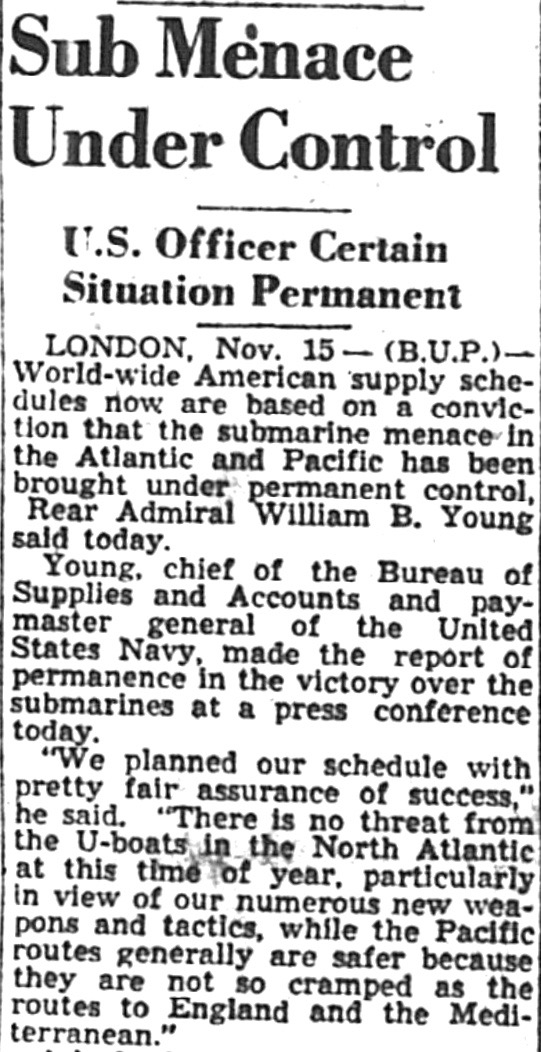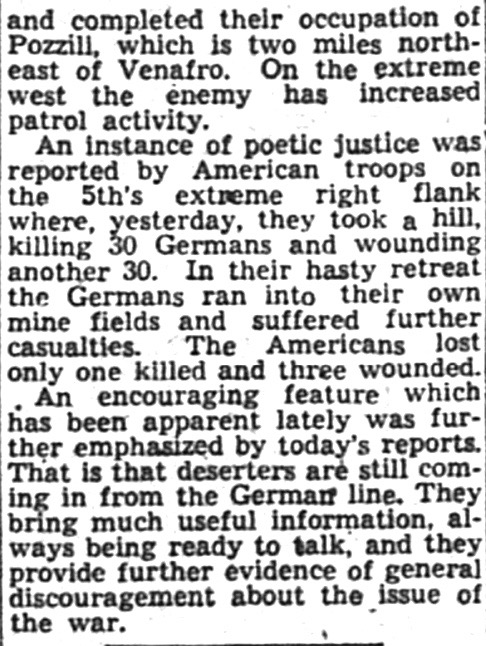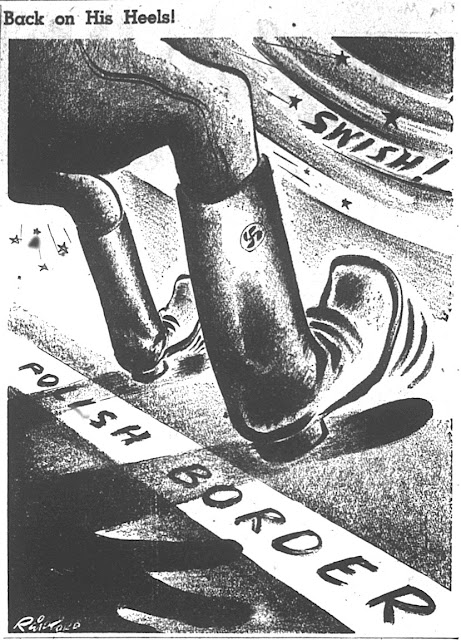Learning How to Deal with Seasickness
First published in the Norwich Gazette in June, 1991
Introduction: My father wrote this article for his hometown, weekly newspaper almost 30 years ago, when he was about the same age I am at present. It finds him recalling a chinwag at the Woodstock Navy Club.
His mention of "an inexpensive meal prepared by navy veterans" makes me wonder if that Navy Club is still on the go. Woodstock is less than an hour away by car and I do like chinwags... and inexpensive meals.
I enjoy going to the Woodstock Navy Club occasionally on Friday for dinner, an inexpensive meal prepared by navy veterans, and there I can sit down with other navy vets amidst some good old navy memorabilia: a ship’s bell, navy flags, and large paintings of warships and ships in convoy that take up whole walls. Encased in a lovely glass cabinet in one wall is a beautiful anchor wreath to remind us of those who died at sea in defence of Canada and other countries.
There is time for some good natured humour though, as well. Recently I found a piece of string on my plate, the type used to tie up a roast, and when I complained to the cook in the galley that I had found someone’s hammock lashing, he jokingly replied that they had plenty, and would I like some more.
The chin wagging at the table leads to the spinning of many salty dips about cramped quarters at sea, action stations, guns, torpedoes, airplanes, the daily tot of rum (now gone), girls, and being seasick.
The only thing I can talk about with any authority is seasickness, because I was never aboard a warship in my navy years (so I couldn’t talk much about most of the other topics circling the table). I went everywhere on Merchant ships and passenger liners. I did spend about six hours aboard a minesweeper during my navy training; the minesweeper, with a rounded bow, rolled so much I could have died standing up, leaning against a ventilator for support, and we weren’t even out of sight of land the whole trip. It felt more like six days than six hours and I thought it would never end.
The minesweeper had its paravane out and we were being instructed on how ships swept the sea for enemy mines. I couldn’t have cared less about mines, paravanes, or anything else; I was having trouble getting my feet to track and my eyes to focus and would have loved to lay down somewhere, preferably ashore, and slept.
I knew I could be navy bound a long time so I learned how to combat seasickness by asking weather-bitten merchant seamen, and the story was usually the same: “Eat dry bread or biscuits and walk.” Although I was to be seasick a couple more times, the advice given by the merchant seamen worked quite well for me and the big percentage of my buddies. However, it was hard to find bread or biscuits for quite some time after the news spread through the ranks.
A few sailors suffered chronic seasickness; once the lines were cast off the dock or jetty these boys were sick the whole trip and usually lay on the hammocks in the hammock locker. But with duties to perform they had to suffer through it regardless; there was no medication for seasickness at that time. We felt sorry for these guys.
Those of us who soon overcame seasickness could live quite well in cramped, smoky, sweaty quarters and regardless of how fierce the oceans rushed by the portholes, our stomachs remained calm and our heads quite clear.
There were times on the ship when the seas were running high and in order to walk, we had to wait for a momentary lull, then make a mad dash a short distance, hang onto something, and wait for the next lull.
The long mess deck tables had raised edges, of course, and if the sea had a lively roll you could be eating off your fellow seaman’s plate if he didn’t keep his arm on the table. If the ship was bouncing end to end then the action was across the tables. There was lots of kye (cocoa) and tea spilled, providing that it had arrived from the galley. But in a sudden lurch just about everything that wasn’t fastened down went flying amidst the cursing, navy style.
I was seasick the first night out on the way to England after eating greasy pork chops (the last I was to see), but I grabbed some bread, clasped my hands behind my back (naval tradition) and walked and walked the length of the ship till quite tired then flopped on a bunk, and even with the sound of falling dishes and pails ringing in my ears, I was soon sound asleep.
I wasn’t seasick again until one day on a ship in the Bay of Biscay. The ocean was angry and many of us were sick as the ship heaved - and so did we. It was a wicked day but eventually I lay down in the scuppers on deck, clinging to a handrail cable running along the side of the ship. As the sea water ran over me, it began to seem soothing now and I felt much better, but I clung to the cable for dear life. I soon recovered and was never a victim of seasickness again.
This all reminds me of talk around my home from my sisters about seasickness years ago. It seems some weekends in the summer about 1930, large pleasure craft used to take men and women on trips from Port Dover to Erie, Penn. I heard the girls talk about people being seasick, and although the band played on, the deck was almost empty of dancers. Some around our house on Spring Street vowed never to go again. Actually, that was a cover-up. It wasn’t because of the fear of seasickness, it was because they didn’t have the money.
Editor’s Notes:
re the paravanes on a minesweeper - the paravane, a form of towed underwater "glider" with a warhead that was used against naval mines and submarines.
Initially developed to destroy naval mines, the paravane is strung out and streamed alongside the towing ship, normally from the bow. The wings of the paravane pull it away laterally from the towing ship, placing a tension on the tow cable. If the tow cable snags the cable anchoring a mine then the anchoring cable is cut by jaws on the paravane, allowing the mine to float to the surface, where it is destroyed by gunfire. If the anchor cable fails to part, the mine and the paravane are brought together and the mine explodes against the paravane. The cable can then be retrieved and a replacement paravane fitted. (link to Wikipedia)
re “the first night out on the way to England” - Canadian sailors were transported overseas aboard the SS Volendam, a Dutch ocean liner, in January, 1942. An earlier attempt to cross the Atlantic took place in December, 1941, but the ship (I believe HMS Bermuda) ran aground on rocks at Chebucto Head (about 20 km. south and west of Halifax) during a blinding snowstorm. Doug and Lloyd mention the same, significant incident in their memoirs.
re "I lay down in the scuppers on deck" - a scupper is an opening in the side walls of a vessel or an open-air structure, that allows water to drain instead of pooling within the bulwark or gunwales (of a vessel), or curbing or walls (of a building).
re seasickness - Lloyd Evans, formerly of Markham, also trained on minesweepers near Halifax. In memoirs he writes, “The highlight of the training was a one-day trip to sea on a Minesweeper for gunnery practice. The whole ship rattled and shook when the four-inch gun went off. It wasn’t all fun - one of our boys was so seasick he pleaded to be thrown over the side!”
When I met with Lloyd a few years ago he said he did not recall meeting or working with my father, even though Dad appeared in one of Lloyd’s WW2 photographs. However, Lloyd did know by name some of Dad’s closest mates.
Lloyd and my father experienced many of the very same events at the same time and their recollections about life aboard landing crafts - the relentless work during the opening stages of an invasion, times of training, times on leave - are similar in many ways. They did hang around with the same crowd while in ports in England and Lloyd possessed a photo of a few mates that included my father, unbeknownst to himself. Though they never became friends, there was an exchange of their books of stories, i.e., I gave Lloyd a copy of my father's memoirs and he gave me a copy of his own. It was a rare deal, not a raw one, and we were both very happy to have connected. Lloyd has since passed away.
Both men were interviewed after returning to Canada in December, 1943. Lloyd by the Ottawa Citizen, Dad by the London Free Press and Brantford Expositor:
Both men knew Chuck Rose of Chippewa (below left) and Al Kirby of Woodstock (centre) quite well. Lloyd is far right, guarding the rolls of wire with a machine gun:
Both men lived aboard landing crafts at times, and in the same port. This is Lloyd's photo and my father appears, fourth from the left, peeking out from behind the fellow who is third from left.
Unattributed Photos GH
He also recalls that he gradually learned how to handle seasickness, which afflicted many young sailors before they even got overseas. Dad wasn't spared but it sounds like he tried remedies that actually worked.
His article is not lengthy, and I have added a few details at the end in order to explain a couple of navy terms he uses, and present a word or two from, and about, Lloyd Evans, another member of RCNVR and Combined Operations that I had the pleasure to meet a few years ago.
Learning How to Deal with Seasickness
I enjoy going to the Woodstock Navy Club occasionally on Friday for dinner, an inexpensive meal prepared by navy veterans, and there I can sit down with other navy vets amidst some good old navy memorabilia: a ship’s bell, navy flags, and large paintings of warships and ships in convoy that take up whole walls. Encased in a lovely glass cabinet in one wall is a beautiful anchor wreath to remind us of those who died at sea in defence of Canada and other countries.
There is time for some good natured humour though, as well. Recently I found a piece of string on my plate, the type used to tie up a roast, and when I complained to the cook in the galley that I had found someone’s hammock lashing, he jokingly replied that they had plenty, and would I like some more.
The chin wagging at the table leads to the spinning of many salty dips about cramped quarters at sea, action stations, guns, torpedoes, airplanes, the daily tot of rum (now gone), girls, and being seasick.
The only thing I can talk about with any authority is seasickness, because I was never aboard a warship in my navy years (so I couldn’t talk much about most of the other topics circling the table). I went everywhere on Merchant ships and passenger liners. I did spend about six hours aboard a minesweeper during my navy training; the minesweeper, with a rounded bow, rolled so much I could have died standing up, leaning against a ventilator for support, and we weren’t even out of sight of land the whole trip. It felt more like six days than six hours and I thought it would never end.
The minesweeper had its paravane out and we were being instructed on how ships swept the sea for enemy mines. I couldn’t have cared less about mines, paravanes, or anything else; I was having trouble getting my feet to track and my eyes to focus and would have loved to lay down somewhere, preferably ashore, and slept.
A paravane being lowered into the sea from an Australian warship in 1940.
Photo credit - Wikipedia
I knew I could be navy bound a long time so I learned how to combat seasickness by asking weather-bitten merchant seamen, and the story was usually the same: “Eat dry bread or biscuits and walk.” Although I was to be seasick a couple more times, the advice given by the merchant seamen worked quite well for me and the big percentage of my buddies. However, it was hard to find bread or biscuits for quite some time after the news spread through the ranks.
A few sailors suffered chronic seasickness; once the lines were cast off the dock or jetty these boys were sick the whole trip and usually lay on the hammocks in the hammock locker. But with duties to perform they had to suffer through it regardless; there was no medication for seasickness at that time. We felt sorry for these guys.
Those of us who soon overcame seasickness could live quite well in cramped, smoky, sweaty quarters and regardless of how fierce the oceans rushed by the portholes, our stomachs remained calm and our heads quite clear.
There were times on the ship when the seas were running high and in order to walk, we had to wait for a momentary lull, then make a mad dash a short distance, hang onto something, and wait for the next lull.
The long mess deck tables had raised edges, of course, and if the sea had a lively roll you could be eating off your fellow seaman’s plate if he didn’t keep his arm on the table. If the ship was bouncing end to end then the action was across the tables. There was lots of kye (cocoa) and tea spilled, providing that it had arrived from the galley. But in a sudden lurch just about everything that wasn’t fastened down went flying amidst the cursing, navy style.
I was seasick the first night out on the way to England after eating greasy pork chops (the last I was to see), but I grabbed some bread, clasped my hands behind my back (naval tradition) and walked and walked the length of the ship till quite tired then flopped on a bunk, and even with the sound of falling dishes and pails ringing in my ears, I was soon sound asleep.
I wasn’t seasick again until one day on a ship in the Bay of Biscay. The ocean was angry and many of us were sick as the ship heaved - and so did we. It was a wicked day but eventually I lay down in the scuppers on deck, clinging to a handrail cable running along the side of the ship. As the sea water ran over me, it began to seem soothing now and I felt much better, but I clung to the cable for dear life. I soon recovered and was never a victim of seasickness again.
This all reminds me of talk around my home from my sisters about seasickness years ago. It seems some weekends in the summer about 1930, large pleasure craft used to take men and women on trips from Port Dover to Erie, Penn. I heard the girls talk about people being seasick, and although the band played on, the deck was almost empty of dancers. Some around our house on Spring Street vowed never to go again. Actually, that was a cover-up. It wasn’t because of the fear of seasickness, it was because they didn’t have the money.
Doug's three older sisters, sitting beside Spring Street. circa 1935-40
Gertie (front), Myrtle (centre; the oldest), Jessie (right)
Editor’s Notes:
re the paravanes on a minesweeper - the paravane, a form of towed underwater "glider" with a warhead that was used against naval mines and submarines.
Initially developed to destroy naval mines, the paravane is strung out and streamed alongside the towing ship, normally from the bow. The wings of the paravane pull it away laterally from the towing ship, placing a tension on the tow cable. If the tow cable snags the cable anchoring a mine then the anchoring cable is cut by jaws on the paravane, allowing the mine to float to the surface, where it is destroyed by gunfire. If the anchor cable fails to part, the mine and the paravane are brought together and the mine explodes against the paravane. The cable can then be retrieved and a replacement paravane fitted. (link to Wikipedia)
re “the first night out on the way to England” - Canadian sailors were transported overseas aboard the SS Volendam, a Dutch ocean liner, in January, 1942. An earlier attempt to cross the Atlantic took place in December, 1941, but the ship (I believe HMS Bermuda) ran aground on rocks at Chebucto Head (about 20 km. south and west of Halifax) during a blinding snowstorm. Doug and Lloyd mention the same, significant incident in their memoirs.
re "I lay down in the scuppers on deck" - a scupper is an opening in the side walls of a vessel or an open-air structure, that allows water to drain instead of pooling within the bulwark or gunwales (of a vessel), or curbing or walls (of a building).
re seasickness - Lloyd Evans, formerly of Markham, also trained on minesweepers near Halifax. In memoirs he writes, “The highlight of the training was a one-day trip to sea on a Minesweeper for gunnery practice. The whole ship rattled and shook when the four-inch gun went off. It wasn’t all fun - one of our boys was so seasick he pleaded to be thrown over the side!”
When I met with Lloyd a few years ago he said he did not recall meeting or working with my father, even though Dad appeared in one of Lloyd’s WW2 photographs. However, Lloyd did know by name some of Dad’s closest mates.
Lloyd and my father experienced many of the very same events at the same time and their recollections about life aboard landing crafts - the relentless work during the opening stages of an invasion, times of training, times on leave - are similar in many ways. They did hang around with the same crowd while in ports in England and Lloyd possessed a photo of a few mates that included my father, unbeknownst to himself. Though they never became friends, there was an exchange of their books of stories, i.e., I gave Lloyd a copy of my father's memoirs and he gave me a copy of his own. It was a rare deal, not a raw one, and we were both very happy to have connected. Lloyd has since passed away.
Both men were interviewed after returning to Canada in December, 1943. Lloyd by the Ottawa Citizen, Dad by the London Free Press and Brantford Expositor:
Both men knew Chuck Rose of Chippewa (below left) and Al Kirby of Woodstock (centre) quite well. Lloyd is far right, guarding the rolls of wire with a machine gun:
Both men lived aboard landing crafts at times, and in the same port. This is Lloyd's photo and my father appears, fourth from the left, peeking out from behind the fellow who is third from left.
Lloyd's memoirs were helped along substantially by Scotsman Geoff Slee, the creator of a website about the history of Combined Operations (link to combinedops.com)
I have included many entries from Lloyd's memoirs on this site. See 'memoirs re combined ops' under the 'click on Headings' in the right hand margin.
Questions or comments can be sent to me at gordh7700@gmail.com
Please link to Articles: Dieppe Raid 1942 - Operation JUBILEE (6)





























